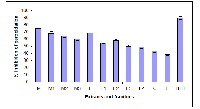Antioxidant potential of different extracts and fractions of Catharanthus roseus shoots
Keywords:
Antioxidant, extracts and fractions of Catharanthus roseus shootsAbstract
Antioxidant effectiveness of indigenous medicinal plant C. roseus shoots extracts and fractions with solvents of different polarity (n–hexane, ethylacetate, methanol, chloroform) was assessed for total phenolics content (TPC), total flavonoid contents (TFC), DPPH radical scavenging activity and % inhibition of peroxidation in linoleic acid system. The C. roseus extracts and fractions contained appreciable levels of total phenolic contents 3.2 to 8.5 GAE (g/100g per dry matter) and total flavonoid contents 1.8 to 5.4 CE (g/100 of per dry matter). The C. roseus shoots extracts and fractions also exhibited good DPPH radical IC50, 28.2 to 119 µg/ml and Inhibition of Peroxidation in Linoleic Acid (38.4 to75.1%) respectively. Of the C. roseus shoots extracts and fractions tested, 100% methanolic extract exhibited the maximum antioxidant activity, the results of the present investigation demonstrated significant (p<0.05) variations in the antioxidant activity. The results of the present comprehensive analysis demonstrated that C. roseus extracts and fractions are a viable source of natural antioxidants and might be exploited for functional foods and nutraceutical applications.
References
Bozin B, Mimica-Dukie N, Simin N, and
Anackov G. Characterization of the
volatile composition of essential oil of
some lamiaceae species and the
antimicrobial and antioxidant activities of
the entire oils. J. of Agri and Food
Chem. 2006;54:1822-1828.
Carew DP and Patterson BD. The effect
of antibiotics on the growth of
Catharanthus roseus tissue cultures.
Lloydia. 1970;33:275–277.
Chaovanalikit A and Wrolstad RE. Total
anthocyanins and total phenolics of fresh
and processed cherries and their antioxidant
properties. Food chem. And toxicol.
;69:67-72.
Chun S, Vattem DA, Lin Y and Shetty K.
Phenolic antioxidants from clonaloregano
(Origanum vulgare) with antimicrobial
activity against Helicobacter pylori.
Process Biochem. 2005;40:809-816.
Dewanto V, Wu X, Adom KK and Liu
RH. Thermal processing enhances the
nutritional value of tomatoes by
increasing total antioxidant activity. J. of
Agri and Food Chem. 2002;50:3010–
Farnsworth NR, Svoboda GH and
Blomster RN. Antiviral activity of
selected Catharanthus alkaloids. J.
Pharmacol. Sci; 1968;57:2174–2175.
Iqbal S, Bhanger MI and Anwar F.
Antioxidant properties and components of
some commercially available varieties of
rice bran in Pakistan. Food Chem;
;93:265-272.
Jaleel CA, Gopi R, Manivannan P,
Gomathinayagam M, Sridharan R and
Panneerselvam R. Antioxidant potential
and indole alkaloid profile variations
with water deficits along different parts of
two varieties of Catharanthus roseus.
Colloids and Surf B: Biointerfaces
;62:312–318.
Jaleel CA, Manivannan P and Sankar B.
Induction of drought stress tolerance by
ketoconazole in Catharanthus roseus is
mediated by enhanced antioxidant
potentials and secondary metabolite
accumulation. Colloids and surf. B,
Biointerfaces. 2007;60:201–206.
Misra N and Gupta AK. Effect of salinity
and different nitrogen sources on the
activity of antioxidant enzymes and indole
alkaloid content in Catharanthus roseus
seedlings. J. Plant Physiol. 2006;163:11–
Mustafa NR and Verpoorte R. Phenolic
compounds in Catharanthus roseus.
Phytochem. ReV. 2007;6:243–258.
Pereira DM, Faria J, Gasparn L, Ferreres
F, Valentao P, Sottomayor M and
Andrade PB. Exploiting Catharanthus
roseus roots: Source of antioxidants. J.
Food Chem. 2010;121:56–61.
Piovan A and Filippini R. Anthocyanins
in Catharanthus roseus in ViVo and in
Vitro: a review. Phytochem. ReV.
;6:235– 242.
Siddhuraju P and Becker K. Antioxidant
properties of various extracts of total
phenolic constituents from three different
agroclimatic origins of drumstick tree
(Moringa oleifera lam.) leaves. J. of Agri.
and Food Chem. 2003;51:2144–2155.
Sultana B, Anwar F and Przybylski R.
Antioxidant potential of corncob extracts
for stabilization of corn oil subjected to
microwave heating. Food Chem.
;104:997–1005.
Velioglu YS, Mazza G, Gao L and
Oomah BD. Antioxidant activity and total
phenolics in selected fruits, vegetables
and grain products. J. Agri and Food
Chem. 1998;46:4113.
Yen GC, Duh PD and Chuang YD.
Antioxidant activity of anthraquinones
and anthrone. Food Chem. 2000;70:307–
Zheng W and Wang SY. Antioxidant
activity and phenolic compounds in
selected herbs. J. Agri. Food Chem.
;49:5165–5170.



